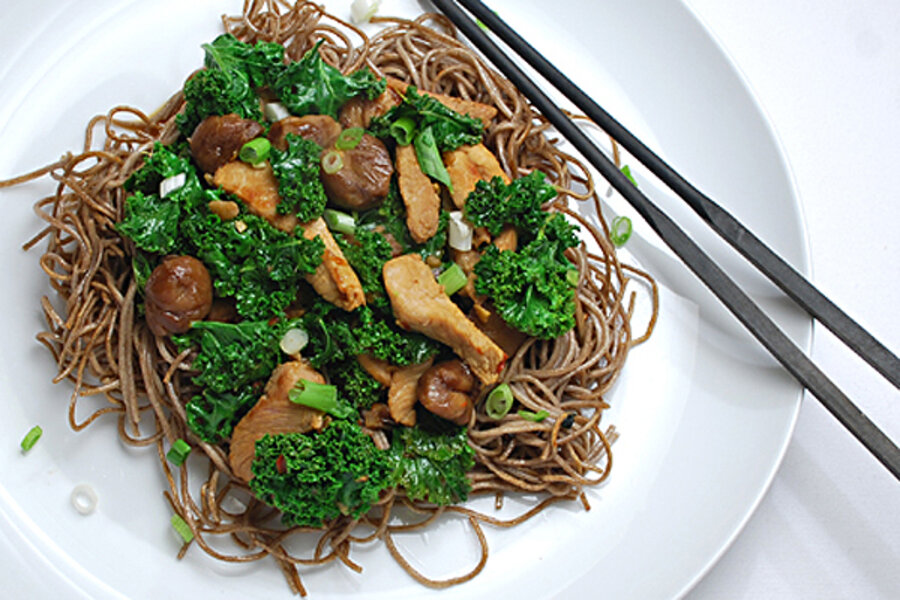Ginger, garlic, and chili paste flavor pork stir-fried with chestnuts and kale and served over gently fried soba noodles.
Serves 4
1 pound pork, cut into 2-inch-long ribbons (I used boneless pork chops)
3 cloves of garlic, minced
1 tablespoons ginger, crushed and minced
2 to 4 tablespoons chili paste (to taste)
A 6- or 7-ounce package of roasted, peeled chestnuts, cut or broken in half (see Kitchen Notes)
8 to 10 stalks of kale, ribs removed and the leaves torn into small pieces
12 to 14 ounces dry soba noodles
Canola oil
4 scallions, roots trimmed, cut into rings
Marinade for the pork:
2 tablespoons soy sauce (reduced sodium preferred)
2 teaspoons cornstarch
1 tablespoon dry sherry [*editor's note: the sherry may be left out with little affect on the marinade]
Sauce:
2 tablespoon soy sauce
1/2 cup water
1 cup chicken stock or broth
1 tablespoon hot bean paste
4 tablespoons dry sherry [*editor's note: the sherry may be substituted with 4 extra tablespoons of soy sauce]
2 tablespoons rice vinegar
2 teaspoon cornstarch
1. Cut the pork into ribbons about 2 inches long. Combine marinade ingredients in a bowl, add the pork, stir to mix everything and set the pork in a cool place. It should marinate for about 15 minutes.
2. While it is marinating, prepare the remaining ingredients. Put a pot of water on to boil, to cook the soba noodles. Combine the ginger and garlic in a small ramekin. Measure out the chili paste in another ramekin. Prepare the roasted chestnuts and tear up the kale. Mix the sauce ingredients in their own bowl.
3. When the pot of water comes to a boil, add the soba noodles and cook until al dente (probably about 6 or 7 minutes). Drain and rinse well in hot water.
4. In a nonstick skillet, heat 3 tablespoons of canola oil. Add the drained noodles, stir and toss them so they are coated with the oil, then continue sautéing them. The goal is to make them nicely, lightly golden.
5. Drain the pork and discard marinade. In another nonstick skillet, heat 2 tablespoons canola oil oil to medium and add the ginger and garlic. Sauté for 90 seconds, then add the pork ribbons and turn the heat up a little. Cook, stirring and turning the pork ribbons, until they are no longer pink. Don’t worry if the ginger and garlic darken – they will taste good.
6. When the pork loses its pink color, add the chili paste. Toss and stir to spread it thoroughly. The amount you add depends on how spicy you want this dish to be. I ended up adding 4 tablespoons, which was twice as much as I expected to add but, in the end, it did not seem that hot. It depends on your palate and how fiery your chili paste seems on the day.
7. At this point, add the chestnuts and gently stir everything together. Turn the heat down.
8. Meanwhile, you are also keeping an eye on the noodles in the other skillet. Golden, not crispy, is your mantra.
9. When the noodles look sufficiently golden, turn the heat low under that pan. Give everything in the pork pan a light stir. Then add the kale, stir all together, and pour the sauce over all. Immediately start stirring and scooping everything together. It will start thickening immediately – keep the liquid moving so it does not stick. If it seems too thick or if you would like greater volume, top up with a mix of soy and stock.
10. When the kale wilts but is still bright green, this is ready. Serve by plating the noodles and dishing the pork on top; or stir everything together in one pan to incorporate it all. Sprinkle with the scallions and then serve.
Kitchen Notes
Make it vegetarian. For the sauce, omit the chicken stock and substitute additional 2 tablespoons soy sauce and 1/2 cup water. Instead of pork, use extra firm tofu, cut into 1-inch cubes and marinated without the cornstarch. And when choosing tofu, select a good quality brand and not the cheap stuff. Avoid the kind in the cardboard box – spend a few more cents for a far better result. Sauté the tofu until it is golden on all sides; after that, handle with care so it doesn’t break up.
Packaged chestnuts. Roasted, peeled chestnuts are now widely available. We used Trader Joe’s, which come roasted and vacuum packed from France. Asian and international markets often carry roasted, vacuum packed chestnuts from China. I like this product because I have never been very good at handling fresh chestnuts, what with the cross-cuts and the peeling and the high temperatures and all – I am always afraid I am going to chop off a hand (mine). So this product is welcome at our house. It’s not exactly fresh roasted, bought from a cheerful North African vendor over by the Rue des Halles, in a cone made from a bit of Le Monde, but it’s pretty darn good.






